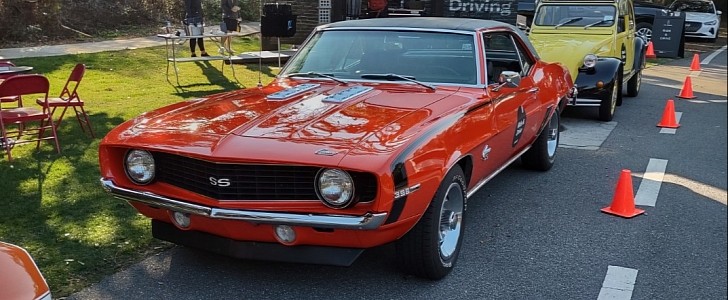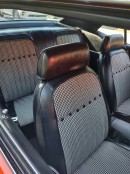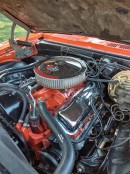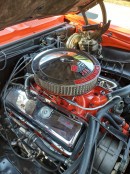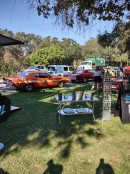Hagerty’s Ride & Drive at The Amelia 2022 included some amazing rides, but one in particular stole my attention after a few miles around the island.
For full journalistic disclosure, I am no stranger to the Chevrolet Camaro. Having owned over a dozen examples over the past 25 years, my curiosity was piqued by this unassuming example. Hagerty Collector Car Insurance is saving our hobby for future generations, and their best efforts involve a collection of unique & significant classics.
Having driven original and cloned examples of the 1969 Yenko Supercar, I decided to see what this ordinary SS had to offer. By 1969, you could order a 7-liter (427) big block that easily offered 450 horsepower with exhaust and intake upgrades. But this car left the factory with the 396 (6.4-liter) V8 that Chevy stuffed in everything from 1965 to 1972.
This car is a perfect example of popular options. It left the factory in Norwood, Ohio loaded with the deluxe interior, center console with auxiliary gauges, and a Muncie 4-speed manual. Perhaps the best option is not the massive V8, but the JL8 disc brakes at all four corners. The only thing missing was a rarity in those days: Air conditioning! On an island with constant 100% humidity, A/C is a necessity for mental health.
After adopting a mindset of minimalism, my Hagerty representative Conner and I set out on a tour of Amelia Island. This flavor of 396 big block was shared with the Impala, Chevelle, Nova, and every other Super Sport car for 1969. Therefore, it needed to have a tiny camshaft and restrictive carburetor to meet early emissions laws. A dead giveaway to its plebeian nature are the smog tubes on the exhaust manifolds. These inject fresh air into the exhaust to lower NOx emissions, but thankfully this was 6 years before the catalytic converter arrived.
The first-generation F-body (Camaro/Firebird) are flimsy even by '60s standards. Without a full frame, the front end is only held to the floorpan by six massive bolts. This allows the front subframe to change geometry into and out of corners, giving drivers a handful of steering to deal with. While it is manageable on the small block (5.7-liter) cars, this 396 has almost 500 lbs (226 kg) more weight between the front wheels. You and the car dance around a boat anchor that is only rated at 325 horsepower.
While that number might be adequate for the time period, GM’s advertising department was sneaky. This flavor of SS 396 engine was tested with no accessories on the dyno. That means your Camaro could honestly only offer 200 horsepower and 274 lb-ft (371 Nm). Without A/C, this car weighs around 3,400 lbs (1,542 kg). That power-to-weight ratio made it feel nearly identical to my stock 1985 Corvette. It offers 330 lb-ft (447 Nm) from a 5.7-liter.
Buyers looking to have fun would have ordered the 350 or 375 horsepower examples of the SS 396. That being said, this car was slow. It felt nearly identical in acceleration to my 5-liter 1987 Camaro IROC, but that car was much lighter and predictable in the corners. It was hot as hell in the Florida sun, which caused vapor lock to creep in around noon.
If you are looking for an original big block Camaro or Firebird, your satisfaction will come from spectators and social media while LS-swapped cars live a life of leisure. Because this is the lowest horsepower big block, originality isn’t a selling point.
Because it is much more affordable than the 6.4-liter cars, you will save money that can be used for A/C, a modern suspension, and a six-speed swap. Stay with us for more honest reviews!
Having driven original and cloned examples of the 1969 Yenko Supercar, I decided to see what this ordinary SS had to offer. By 1969, you could order a 7-liter (427) big block that easily offered 450 horsepower with exhaust and intake upgrades. But this car left the factory with the 396 (6.4-liter) V8 that Chevy stuffed in everything from 1965 to 1972.
This car is a perfect example of popular options. It left the factory in Norwood, Ohio loaded with the deluxe interior, center console with auxiliary gauges, and a Muncie 4-speed manual. Perhaps the best option is not the massive V8, but the JL8 disc brakes at all four corners. The only thing missing was a rarity in those days: Air conditioning! On an island with constant 100% humidity, A/C is a necessity for mental health.
The first-generation F-body (Camaro/Firebird) are flimsy even by '60s standards. Without a full frame, the front end is only held to the floorpan by six massive bolts. This allows the front subframe to change geometry into and out of corners, giving drivers a handful of steering to deal with. While it is manageable on the small block (5.7-liter) cars, this 396 has almost 500 lbs (226 kg) more weight between the front wheels. You and the car dance around a boat anchor that is only rated at 325 horsepower.
While that number might be adequate for the time period, GM’s advertising department was sneaky. This flavor of SS 396 engine was tested with no accessories on the dyno. That means your Camaro could honestly only offer 200 horsepower and 274 lb-ft (371 Nm). Without A/C, this car weighs around 3,400 lbs (1,542 kg). That power-to-weight ratio made it feel nearly identical to my stock 1985 Corvette. It offers 330 lb-ft (447 Nm) from a 5.7-liter.
If you are looking for an original big block Camaro or Firebird, your satisfaction will come from spectators and social media while LS-swapped cars live a life of leisure. Because this is the lowest horsepower big block, originality isn’t a selling point.
Because it is much more affordable than the 6.4-liter cars, you will save money that can be used for A/C, a modern suspension, and a six-speed swap. Stay with us for more honest reviews!
